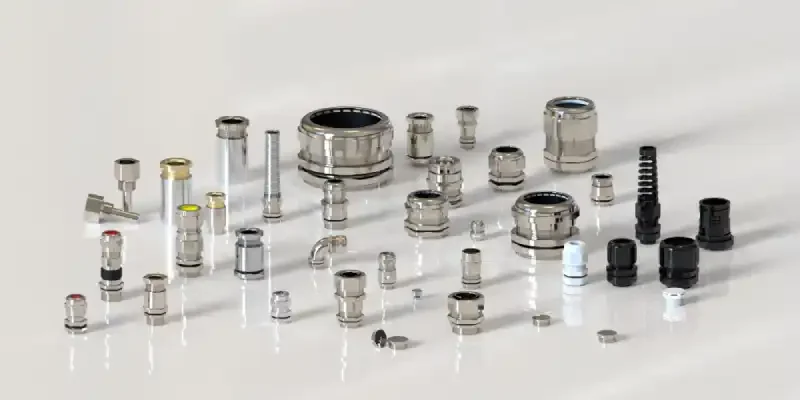Cable glands are vital for securing and protecting electrical cables. They play a crucial role across different industries by ensuring cables remain safe and undamaged. Selecting the right material for your cable gland is essential for its performance and durability. In this article, we’ll explore the various materials used in cable glands, their properties, and their suitable applications.
Metal Materials
Brass
Brass is a popular choice for cable glands. Often nickel-plated, brass offers excellent corrosion resistance. It’s known for its durability and good electrical conductivity, making it perfect for plumbing, gas, power, and electrical equipment. Brass can handle demanding environments due to its heat conduction properties and resilience.
Stainless Steel
Stainless steel, available in grades like SS304 and SS316, is highly resistant to corrosion. It’s ideal for harsh environments, including petrochemical, pharmaceutical, and marine settings. Stainless steel cable glands are reliable and long-lasting, ensuring safety and consistency under challenging conditions.
Aluminum
Aluminum cable glands are lighter than brass and stainless steel but still provide good electrical conductivity and thermal stability. They are often used where weight is a concern, such as in electric vehicles. Aluminum’s strength and lightness make it suitable for various industrial applications.
Plastic Materials
Nylon (Polyamide)
Nylon cable glands are versatile and resistant to moisture and chemicals. They perform well in a wide temperature range (-40°C to 135°C), making them suitable for power supply lines, instrumentation, and lighting fixtures. Their adaptability and durability are ideal for many applications.
Polypropylene (PP) and PVC
Polypropylene and PVC are cost-effective options for less demanding environments. They offer good insulation properties but may not withstand extreme conditions. These materials are perfect when budget constraints are a priority without compromising basic performance.
Thermoplastic Elastomers (TPE)
TPE materials provide flexibility and weather resistance, ensuring reliable sealing in various applications. Their adaptability to different environmental conditions makes TPE cable glands a versatile choice for both industrial and consumer uses.
Specialty Materials
Copper
Copper cable glands, though less common, are valued for their excellent thermal conductivity. They are used in high-temperature applications where effective heat dissipation is crucial. Copper’s unique properties make it suitable for specific high-demand situations requiring superior thermal management.
Factors to Consider When Choosing a Cable Gland Material
When selecting a cable gland material, consider these factors to ensure optimal performance and longevity:
- Environmental Conditions: Exposure to moisture, chemicals, and extreme temperatures.
- Mechanical Stress: Strain and pressure that the cable gland will endure.
- Thermal Requirements: The temperature range within which the cable gland must operate efficiently.
- Application Needs: Specific requirements based on the industry, such as electrical conductivity, weight, and flexibility.
Conclusion
Choosing the right material for your cable glands ensures the safety, efficiency, and longevity of your electrical installations. Whether you need the durability of stainless steel, the lightweight properties of aluminum, or the versatility of nylon, understanding the strengths and applications of each material helps you make an informed decision. Properly considering all relevant factors enables you to select the cable gland that best meets your specific needs, enhancing your system’s overall performance.
By keeping these points in mind, you can ensure that your electrical installations remain secure and function optimally across various conditions and applications.


